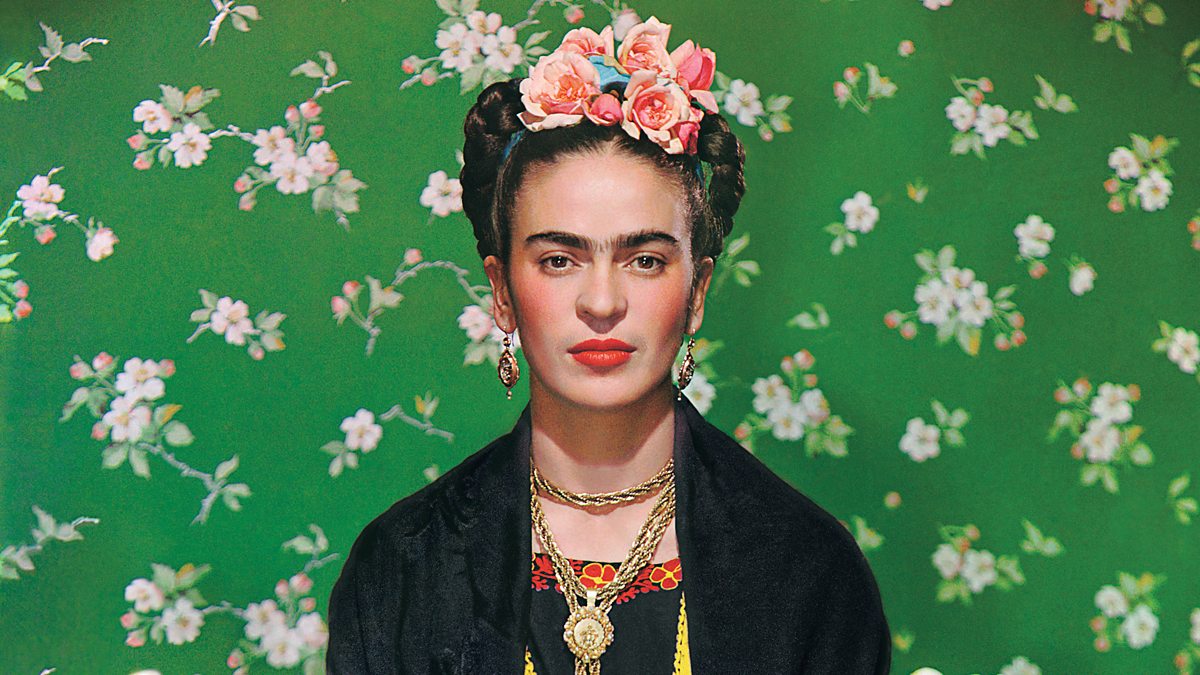Becoming Frida
A BBC documentary revisits the life and legacy of Mexico’s iconic artist. Image courtesy of Rogan Productions.
Image courtesy of Rogan Productions.
Frida Kahlo was born in 1907, three years before the Mexican Revolution. As a teenager, she attended the National Preparatory School in Mexico’s capital, where she excelled in anatomy and looked forward to medical school and becoming a physician. But in 1925 her goal was sideswiped by a trolley that crashed into the rickety wooden bus that she regularly took home from school. On impact, the tram’s iron handrail impaled her spinal column and exited her vagina, shattering spine and pelvis. She lived with the aftereffects of the accident for the rest of her life.
Frida (commonly known by her first name, like Beyoncé) was not expected to live. She defied the doctors just as she would defy social conventions. Her study of anatomy would prove serendipitous. In her convalescence, the bedridden would-be doctor began sketching, often using herself as a model. Her paintings, most small as a sheet of computer printing paper, have an outsize impact on the viewer, on Mexican identity and on modern art.
“Becoming Frida Kahlo,” Louise Lockwood’s three-part BBC miniseries that airs on PBS starting this week, is strong on sociopolitical context and archival research. Visually, the documentary comes alive when it focuses on Frida’s vivid portraits or on photographer Nikolas Muray’s lush color studies of the artist, erotic as Hollywood glamour shots. In this, the documentary is Frida for the Instagram age. Emotionally, it connects when Cristina Kahlo, Frida’s great-niece, or Juan Coronel Rivera, grandson of Frida’s husband, muralist Diego Rivera, talk about their storied antecedents. Art historian Luis-Martin Lozano, and Kahlo biographers Hayden Herrera and Martha Zamora provide insights into Frida’s life and work.
Over three episodes, Lockwood succeeds in tracing the arc of her subject’s life and identifying several of Frida’s Who’s Who of lovers. They include Soviet revolutionary Leon Trotsky and American painter Georgia O’Keeffe.
While the cradle-to-grave narrative is a good introduction to Frida’s life, those familiar with her art will note that the documentary is more focused on her biography and secular sainthood than her work. The occasionally glib narration — “art was Frida’s superpower” — and clichéd, oversimplified summaries — “From the beginning, Frida’s work is about herself, exorcising her demons” — do its subject an injustice.
While the cradle-to-grave narrative is a good introduction to Frida’s life, those familiar with her art will note that the documentary is more focused on her biography and secular sainthood than her work.
Just because she figures in many of her paintings does not mean they are only about herself. Often, her self-portraits are portraits of Mexico. Like her country, Frida was mezcla, a mix. Her father was German; her mother Oaxaca-born, of Indigenous and Spanish parentage. Like many female artists throughout history, Frida had a father who was himself an artist. Guillermo Kahlo, an architectural photographer, recruited Frida to color-tint his prints by hand.
While the miniseries looks at “The Two Fridas”(1939), it fails to bring us into the painting. At 5 ½ x 5 ½ feet, it is one of her largest works. In it, she wrestles with the political connections and tensions of her European and Indigenous heritages. At the same time, the allusive canvas likewise wrestles with her feelings about her tumultuous marriage to, and separation from, Diego Rivera. (She loved him madly, and vice versa, but he couldn’t resist other women. These included her sister, Cristina, Mexican-born Hollywood actress Dolores del Rio and the ebullient film star Paulette Goddard.)
In the stunning double self-portrait, the Frida on the left wears a lace-embellished European wedding dress. The Frida on the right is clad in an iris-blue and sunflower-yellow huipil, the tunic favored by Indigenous women since the 10th century. The two Fridas clutch hands. Over the left breast of each is an exposed heart and a tangle of arteries connecting the pair. Euro-Frida’s heart is broken; Indigenous Frida’s heart is intact. Euro-Frida holds scissors in one hand and has severed an artery leaving blood splatters on her dress. Indigenous Frida sits proud and strong, clutching a tiny portrait of Diego in her hand.
Forgive me. It’s unfair to criticize a movie — or a painting or a book — for what is not there. To its credit, “Becoming Frida Kahlo” does pause to consider “Self-Portrait at the Borderline Between Mexico and the United States.”In this mordant 1932 work, the sun and moon hover above a pre-Columbian temple on the Mexico side, and blooming dahlias are rooted in the soil. On the U.S. side, the stars-and-stripes flies over smokestacks and turbines, and instead of vegetation, electrical machinery is plugged into the ground. In the center of it all stands Frida, clutching a Mexican flag, indicating her preference for culture and cultivation over industrialization. Frida’s work could be immediately understood both by the illiterate and the educated.
In their native country, Frida and Diego were embraced as proponents of mexicanidad, a cultural crusade celebrating Mexican identity. When Andre Breton, the French author of the Surrealist manifesto, met Frida, he pronounced her one in his transnational movement. This one-woman zeitgeist was her own movement, the maker of self-portraits that were at the same time political allegories. The documentary likewise purveys her canvases frankly depicting her physical pain. One is “The Broken Column” (1944), painted after one of her many surgeries. She shows herself in a surgical corset, a shattered Doric column in place of her spine, nails piercing her torso as if to keep the column in place. Did painting it give her reprieve, however brief, from physical agony?
While the miniseries looks at “The Two Fridas”(1939), it fails to bring us into the painting.
A brief digression from the documentary for a related point. About the time of Frida’s centenary, I was at a folk-arts gallery purveying handcrafted ceramics and jewelry. A colorful amulet in the case caught my eye. I asked the owner if its female likeness was Shiva, the Hindu deity of transformation. “It’s from India,” she said, “but it’s Frida.” Somewhere on the Asian subcontinent, an artisan had beatified the Mexican painter as a transformer of pain. That brand of identification, spoken of as “Fridamania” or “Fridolatry,” was mostly a posthumous embrace of her work.
Frida predeceased the ailing Rivera by three years. He sold most of his and her available work to his patron, Dolores Olmedo, not exactly an admirer of Frida or her art. For a generation, Frida’s legacy went into eclipse. North of the Mexican border, Frida was resurrected by two affirming forces: Latina artists such as muralist Judy Baca who paid tributes to her in the 1960s and 1970s, and Hayden Herrera’s 1983 biography.
Years ago, Baca observed that “Frida unified Europeanized Mexico with pre-Columbian Mexico in the way that Guadalupe, “the brown Virgin,” unified European Christianity with Indigenous beliefs in Mexico.” That’s a keen summation of the artist’s superpower. Although not quite as sophisticated, the documentary’s conclusion speaks to those encountering Frida for the first time. As Frida biographer Martha Zamora observes, “Whoever opens a door or a window, opens it for everyone. And Frida opened it for a lot of artists.”
Your support matters…Independent journalism is under threat and overshadowed by heavily funded mainstream media.
You can help level the playing field. Become a member.
Your tax-deductible contribution keeps us digging beneath the headlines to give you thought-provoking, investigative reporting and analysis that unearths what's really happening- without compromise.
Give today to support our courageous, independent journalists.






You need to be a supporter to comment.
There are currently no responses to this article.
Be the first to respond.